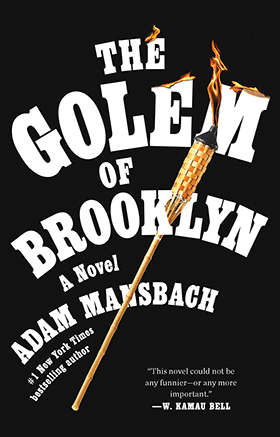Reviewed by NEAL GENDLER
Utterly preposterous, profanity laden and very clever, The Golem of Brooklyn is an unpredictable, crazy-quilt twist on the old story of a man-made rescuer of Jews whose successes become a burden.
But the golem in this story isn’t made by a rabbi, in the manner of the Golem of Prague.
This golem is the result of several hundred pounds of premium sculpting clay, stolen one five-pound brick a week for years by Len Bronstein, an art teacher in Brooklyn Heights.
“He didn’t really know why,” author Adam Mansbach says. “Len was no sculptor; his artistic disciplines were not-painting and not-writing.”
Stoned on weed, Len one day decides to write a novel around ancestral trauma — a theory consuming four pages — then ditches the idea and goes to his garden storage shed. Staring at the mass of purloined clay, he decides to make a golem, the definition and history of which is described for us.
Len creates a nine-and-a-half-foot humanoid with shoulders of which he is particularly proud and klutzy feet of which he is not. Following the golem story, he carves onto its forehead the letters aleph, bet, tav, which spell “truth,” and recites transliterated incantations from the internet.
Nothing appears to happen, so Len returns to his apartment, only to be shocked when his back door is ripped off and The Golem strides inside! Not only that, but it speaks. In Yiddish.
Len, who doesn’t, rushes out to find an interpreter, and asks a young woman working at a bodega if she speaks Yiddish. Of course she does. She’s Miriam Apfelbaum, a young lesbian barely scraping by as Miri after fleeing her upbringing among New York’s Sassov Hasidic dynasty.
Miri translates what appears to be Yiddish — shown in English letters — and eventually we’re told a bit ungrammatically that “there has only ever been one golem. He is not made but remade” and “is a repository of memories.” He has appeared over the centuries when Jews were in trouble, fighting for them until he’s returned to some kind of nonexistence by erasing or filling in the aleph, creating the Hebrew word “met,” meaning “dead.”
Len’s golem, of gigantic strength, also is very intelligent, having taught himself a crude but usually sufficient English by a day of watching Curb Your Enthusiasm on Len’s TV. When The Golem’s English blanks, Miri translates.
This and the bizarre adventures that follow all are fun and often funny, but a warning: The breezy-reading Golem is strewn with the most profanity I’ve ever encountered in a book — so much I’m surprised that an imprint of Random House would publish it, even if Mansbach is an accomplished author whose writing has appeared in the most respectable of periodicals. These cover-your-children’s-ears words are most dense in the first half of the book and taper off. Some chapters have almost none.
The golem becomes a problem after learning of a “Jews Won’t Replace Us” rally set for a Kentucky town. The golem wants to kill the demonstrators. Miri persuades Len to take the golem there, but only to frighten the racists.
A diversion: First, the golem insists he speak with the Admor, head of the Sassov dynasty. The outcast, disgraced Miri bulls her way into the headquarters of Sassov’s protective vigilantes and eventually, the golem is on a knee in obeisance to the Admor.
Miri and Len learn that the dynasty is planning a city for itself in upstate New York, with the property and permits obtained through corruption. The dynasty’s “fixer” takes them and the Admor to the site, where he’s to persuade the local congressman to back the plan.
The congressman starts by telling them how unwelcome the Jews will be and continues into antisemitism. The golem leaps out of the large van in which he’s arrived and grabs the congressman, who drops dead in fright.
Len, Miri and the golem take off, now fugitives driving a black Sassov luxury SUV from which the golem has ripped out the last two rows of seats to make room for himself. After a stop with Len’s Uncle Josh, a wealthy recluse deep in a forest, they’re back on the road when a state trooper stops and pulls his gun on Len. The golem throws the trooper and his car beyond the highway tree line. Len says he won’t take the golem to the rally. The golem flings Len upward and leaves.
Knowing the golem will head for the Kentucky town, Len and Miri race there to try to prevent a massacre. Along his way, the golem meets Lilith and befriends a young girl whose father lets him stay in return for digging a septic pit that makes the golem stink.
This all requires an enormous suspension of disbelief and f-word tolerance, but it’s amusing and includes a few fairly serious portions, some giving a quick overview of Jewish history. And the author or his helpers know to use “Sea of Reeds.”
Mansbach is nothing if not inventive. Imagine using tefillin straps — but not the boxes with sacred text — to rescue a man 30 feet up a tree.
***
Neal Gendler is a Minneapolis writer and editor.
(American Jewish World, February 2024)




















